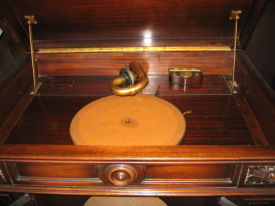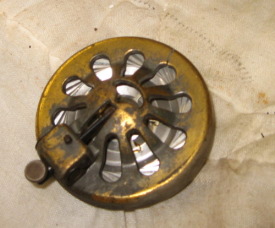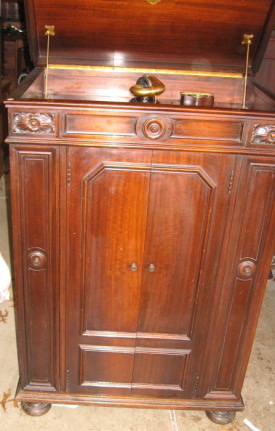
Orthophonic Victrola Credenza
This article is part of the ANTIQUE PHONOGRAPH, GRAMOPHONE AND TALKING MACHINE IDENTIFICATION GUIDES.
SEE ALSO: Our listings of Victrolas for sale.
By late 1924 it was apparent that Victrola sales were well into a long slump, due to competition from free broadcast radio. Although electrical amplification of phonograph records was still around the corner, experiments were being conducted with electrical recording, and the Western Electric division of Bell Laboratories was the first to develop a workable system.
At the same time, it was recognized that the new electrically recorded discs would require a horn and reproducer of more scientific design. The construction of phonograph horns had long been a matter of trial and error, but by the teens basic principles of acoustics had become understood..
The new electrically recorded records offered an increase in frequency range of over two octaves, primarily on the bass end. By translating formulas of electrical energy to mechanical energy it was determined that a horn which increased in exponential proportions from its mouth to its opening was best suited for the new recordings. .
Western Electric offered exclusive rights to Victor, which dithered on the purchase, perhaps due to owner Eldridge Johnson's melancholia (depression), or perhaps because Victor was working on a system of its own. By the time Victor accepted Columbia had also acquired rights to the process, and had committed to its own machine, the Viva-Tonal. .
The new Victor machines, dubbed Orthophonic (Greek for 'true sound') were introduced November 2, 1925 with an advertising barrage immense even by Victor standards. They were in fact true revelations, a sea change in acoustic recording, everything Victor advertising had hyped them up to be.
In advance of the new Orthophonics Victor had surreptitiously begun issuing electrical recordings -- these discs are marked VE (Victor electrical) on the label..
The largest and most expensive of the new Orthophonics was the Orthophonic Credenza, selling at $275. It featured a re-entrant horn folded in upon itself 72 inches long. The case, styled in the fashion of an ornate Italian Credenza, was unlike any prior Victrola. .
The earliest version of the Credenza had only two doors. Later, more commonly seen Credenzas had four doors, two small doors for record storage and two large doors to expose the horn. The Orthophonic Victrola was available in walnut or mahogany, although once oversprayed with lacquer it is hard to tell the finishes apart. A cabinet with Moroccan leather front could be special ordered. The Credenza could be purchased with quadruple spring motor, AC-DC motor, or DC motor..
The Orthophonic Credenza and its successor the 8-30 were one of the best-selling Victrolas. Many examples have survived, partly perhaps because its heft and size did not make it easy to dispose of..
In 1927 some small changes were made to the Credenza and the model was redesignated as the 8-30. It is essentially the same machine.
Here are some scans of an original catalogue for the Orthophonic Credenza, ca. 1926.

Victrola Credenza upperworks. The traditional Victor tapered tone arm was replaced by the swan's neck tone arm. Earlier Credenza tone arm assemblies were supported by a set of ball bearings at the base.
Larger image

Moroccan leather finish. The leather was coated with shellac, which age darkens with the years. It is possible to bring back the original vibrant colors by gently wiping away the shellac.
Larger image

Gold plated Orthophonic reproducer. A new design, significant changes were made versus the prior Victrola Number 2 reproducer. The fulcrum assembly in the needle chuck was replaced with a group of ball bearings. The mica diaphragm was replaced with a metal diaphragm, and the connection to the diaphragm was now in the shape of a spider.
Larger image

Early Orthophonic reproducers were cast of brass, later ones of pot metal. How to distinguish between the two? One easy way is to examine the shell opposite the needle chuck. If you see a circle, as in the picture above, it's pot metal. If you see a slot, it's brass.
Larger image

Lynn Bilton
Box 435
Randolph,OH 44265
330 325-7866
We buy, sell, and repair antique phonographs and music boxes.
Pick-up and delivery possible in many parts of the midwest, south, and northeast.
Mechanical music
for sale

 For Sale
For Sale


 Contact/
Contact/



